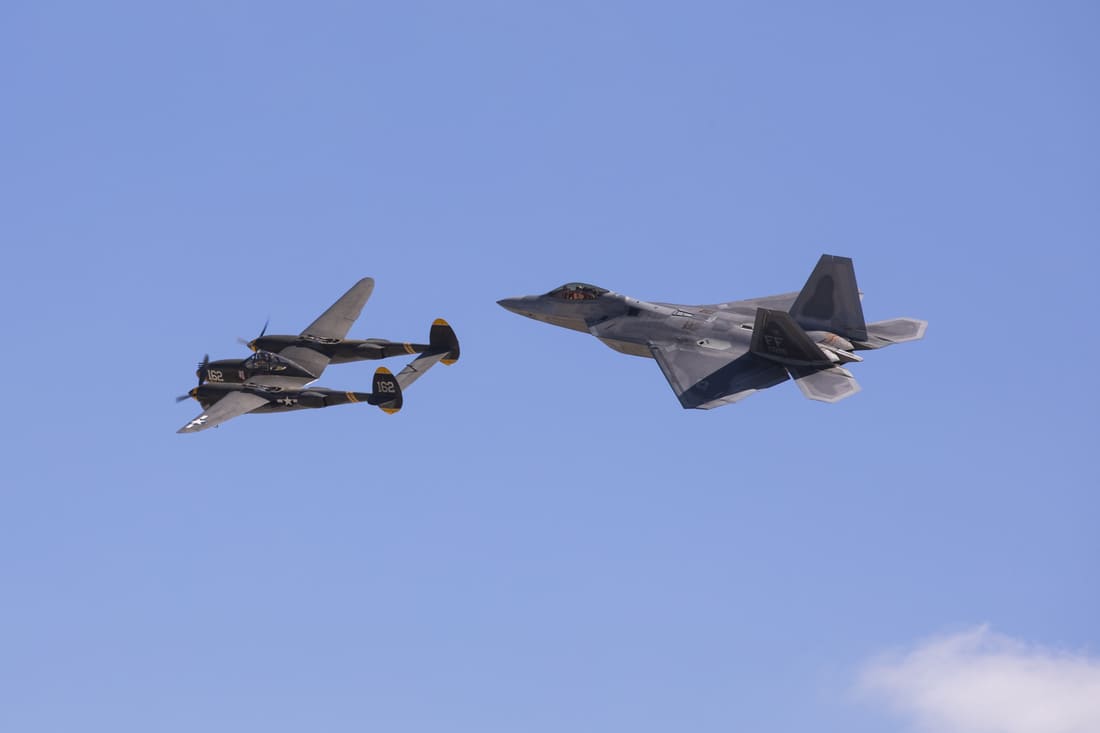“If a system is not capable of operating in a contested environment, then we need to be second-guessing how much money we’re dumping into readiness on those platforms,” Secretary of the Air Force Troy Meink said at National Harbor during the 2025 Air, Space and Cyber Conference. He tied maintenance manpower and parts to aircraft that can survive against modern defenses and signaled tighter choices across fleets.
Months of data show declines across several measures the service uses to judge whether aircraft can fly assigned missions on any given day. Meink described F-22s parked at Joint Base Langley-Eustis with no work underway because the right components weren’t on hand. “When I go out to Langley and there’s a number of aircraft, nonoperational, sitting around the ramp that aren’t even being worked on because we simply don’t have the parts to do that – that’s a problem,” he said.
Defense officials confirm the parts backlog at several units has forced maintenance to triage aircraft that are closest to return-to-service while tails deeper in the queue wait.
“When we’re getting a part that’s supposed to last 400 hours, and it lasts 100 hours, that’s unacceptable,” Meink said. The department would work with companies to target failure modes and improve mean time between failures on components that drive the most downtime.
Cheap quadcopters modified for the battlefield have hit far more expensive systems in Ukraine, pushing planners to assume a future fight where survivability and cost per effect matter more than platform prestige. Manpower and money should go to aircraft that can live in a dense threat picture.
Readiness Rates and Availability Trend in Fiscal 2024
The officially reported average across all fleets came in at 67.15 percent in fiscal 2024, the lowest in at least a decade. A weighted view that gives heavier influence to high-density fleets placed the rate closer to 62 percent which means roughly four in ten tails were down on an average day.
Availability – a related statistic that tracks ready aircraft against the inventory – shows the longer slide. Senior leaders briefed a drop from about 73 percent in 1994 to near 54 percent in 2024. The average aircraft age rose in the same span from about 17 years to just under 32 years. According to industry sources, the age curve now intersects large depot workloads and vendor attrition for legacy parts, which extends repair cycles and raises costs per flying hour.
The F-22’s mission-capable rate fell to around 40 percent in 2024. The CV-22 posted near 30 percent after safety stand-downs and component problems. KC-46 availability settled around 61 percent last year, while the F-16C dropped into the mid-60s. T-38C availability reached the mid-50s amid delays to its replacement.
Bases with combat-coded squadrons that would move early in a contingency are receiving additional intermediate-level maintenance support and accelerated parts kits. Units that fly aircraft unlikely to deploy against high-end threats will keep flying and training, but they will not outrun shortage lines set by higher priority fleets.
As types leave service, the Air Force plans to shift experienced maintainers to fleets slated for combat roles in a future conflict. Defense officials confirm the manpower plan includes targeted retraining pipelines so maintainers from retiring fleets can qualify on fifth-generation jets and advanced surveillance aircraft faster than past crossflows.
Components that fall far short of life estimates drive repeat removals, longer repair queues and idle jets. The department intends to use contract levers tied to on-wing life, first-pass yield at repair, and turnaround time at depots. According to industry sources, several contracts now under draft include stronger incentives on those metrics and clearer penalties when vendors miss them without cause.
F-22 Sustainment Issues at Langley
Langley’s F-22 units show how parts shortfalls ripple across a wing. When a single avionics box or hydraulic component is short, maintainers often park multiple jets while they cannibalize a small number of parts to keep training lines moving. Each swap burns man-hours and risks collateral damage on connectors and wiring.
The Raptor’s 2024 readiness reflects those dynamics. A combination of obsolescence, limited vendors for unique items, and lengthy repair loops hurt availability. According to industry sources, items with complex coatings or low-rate manufacturing steps now have multi-month lead times. Reliability shortfalls add a second hit, and Meink’s 400-hour example matches the life gap maintainers report on several components across different fleets.
Programs can track removals per 1,000 flying hours, the average calendar days a part spends in repair, and the percentage of returns that pass test on the first try. Contracts that tie fees to those outcomes give vendors stronger reasons to fix the items that strand aircraft. Defense officials confirm several programs are preparing to restructure sustainment awards along these lines, with data-sharing requirements that let the government verify results without delay.
Heavy ISR and special operations fleets report similar choke points on select components. Older tankers and fighters face vendor attrition as companies exit lines that no longer support business cases which leaves the government to bridge the gap through reverse engineering or small-batch buys.
Acquisition Modularity and Supply Chain Review
William D. Bailey, performing the duties of the assistant secretary for acquisition, technology and logistics, has emphasized modular designs on new programs so that line-replaceable units can be swapped faster and upgraded without deep rewiring or structural changes. He directed a review to pinpoint where supply chains hold up spares and to clear those with additional sources, repair capacity, or redesign.
Avionics racks and power modules built as common units allow depots to stock fewer variants and turn repairs more quickly. When a single module fails at higher-than-planned rates, the service can work with the vendor on a targeted fix while the rest of the system stays stable. According to industry sources, programs are mapping which modules drive the most non-mission-capable hours and adjusting buys to raise buffers at those exact spots.
Maintenance system records already capture removal dates, fault codes, time on wing, and post-repair outcomes. The Air Force is pushing those data into models that predict which tail numbers are likely to go down next and which parts need pre-positioning to prevent grounded jets. Early tests at a handful of squadrons show higher sortie completion rates when line chiefs receive a forward look of likely failures and stage the right parts and tools one shift early. Defense officials confirm those pilots are expanding to more bases this quarter.
Leadership has sought increases in operations and maintenance lines tied to parts, depot work, and flying hours. The target is the blend that reduces non-mission-capable for supply and raises sortie completion without starving modernization. Officials involved in the planning say the budget adds will be paired with stronger sustainment metrics inside contracts.
As legacy fleets retire in larger numbers, maintainers with years of experience can transfer to fleets that match the contested fight. Units that receive those maintainers report faster fault isolation and fewer repeat discrepancies, which compounds over a month into higher availability.
Average fleet age will not reverse quickly. The immediate question is where the service sends its maintainers and its spares in the next three to four quarters. Survivable, combat-coded aircraft will come first when choices are hard.
Fighter and special operations fleets posted some of the sharpest declines in 2024, while a few ISR types improved after targeted component fixes. Tankers held in the low 60s as new aircraft worked through maturity issues. Trainers slipped as a replacement program slid to the right.
Several vendors at National Harbor described work to raise on-wing life on specific electronics and pumps and to add automated test rigs that cut time in repair. Defense officials confirm the department will insert those improvements into award-term decisions and fee pools where the data support them.
If a platform is unlikely to fight through the defenses that define the next conflict, commanders should reevaluate how much scarce manpower and money they commit to its day-to-day readiness. The official average masks heavy variance by fleet, and the weighted calculation highlights how declines in large communities pull the fleet down. Concentrating maintainers and spares on survivable fleets offers the fastest path to more available combat power without waiting for new programs to arrive in volume.
REFERENCE SOURCES
- https://www.gao.gov/assets/gao-23-106217.pdf
- https://www.af.mil/News/Article-Display/Article/4311661/meink-stresses-innovation-focus-funding-to-maintain-air-space-superiority/
- https://www.af.mil/News/Article-Display/Article/4184545/senate-confirms-meink-to-be-nations-27th-air-force-secretary/
- https://www.spaceforce.mil/Biographies/Display/Article/4198319/secretary-of-the-air-force-dr-troy-e-meink/
- https://www.defensenews.com/air/2025/09/22/usaf-must-focus-maintainers-on-key-planes-as-readiness-suffers-meink/
- https://www.airforcetimes.com/air/2025/09/22/usaf-must-focus-maintainers-on-key-planes-as-readiness-suffers-meink/
- https://www.nationaldefensemagazine.org/articles/2025/9/22/afa-news-new-air-force-secretary-sees-significant-readiness-challenge
- https://www.airandspaceforces.com/air-force-mission-capable-rates-fiscal-2024/
- https://www.defensenews.com/air/2025/03/06/air-force-aircraft-readiness-plunges-to-new-low-alarming-chief/
- https://www.yahoo.com/news/air-force-aircraft-readiness-plunges-200000072.html
- https://www.defenseone.com/policy/2025/04/state-air-force-2025/404671/
- https://www.airandspaceforces.com/fixing-air-force-readiness-will-take-years/
- https://www.airandspaceforces.com/weapons/f-22/
- https://www.dvidshub.net/news/498303/f-22-raptor-marks-20-years-operational-service
- https://docs.house.gov/committee/calendar/ByEvent.aspx?EventID=118465
- https://www.congress.gov/119/meeting/house/118465/witnesses/HHRG-119-AS00-Bio-BaileyW-20250723.pdf



